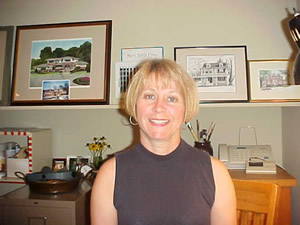 |
|
|
| Age: |
45 |
| |
|
| Hometown: |
Kirkwood,
MO |
| |
|
| Profession/Type of
Art: |
House portraits: watercolor
paintings or black & white drawings |
| |
|
| Education: |
BA, Interior Design,
University of Missouri-Columbia |
| |
|
Mary Beth Flynn grew up in the Kirkwood area attending Kirkwood schools
and John F. Kennedy High School before pursuing interior design at
the University of Missouri in Columbia. Using her educational background,
Flynn worked for several years doing architectural drawings.
After a divorce,
Flynn knew she wanted to work in her home in order to be available
to her three children. Her artistic talent first led
her into creating greeting cards. She was successfully placing her
cards in local stores, but she realized that the greeting cards would
not be a lucrative enough venture to support her. She did not want
to return to her career outside of her home, and when she was
asked to draw a home for a real estate agent, her career doing
house portraits began.
She
expanded her business through Home Decorators Collection
Catalogue,
with a circulation of 5 million across the country. Customers
would send orders with photographs. Flynn was with them for
two years and did enough volume to have to hire help. She and
the catalogue parted company when they advised her that the
numbers were not working for them. Flynn returned to the St.
Louis market and was able to charge the catalogue price which
meant a raise for her, since she did not have to sell through
the catalogue.
Currently,
Flynn can do eight to ten portraits a month, and she has one
contract employee. Holidays remain her busiest time.
Her work
has been featured in the St. Louis Business Journal, St.
Louis Homes & Lifestyles Magazine, the St. Louis
Post-Dispatch,
as well as on the air on KSDK Show Me St. Louis. |
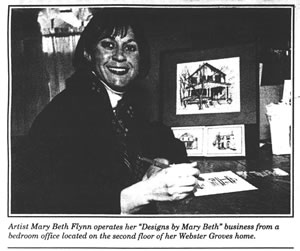 |
Flynn resides
in the St. Louis area. She has three sons. Sean is nineteen and attends
college. Patrick, fifteen years old, is at DeSmet High School,
and Michael, thirteen, attends Webster schools in the seventh grade.
The following interview with Mary Beth Flynn was conducted by Cheryl
Blake, UM-St. Louis, September 2004.
Q. How did you get started in this business of house portraits?
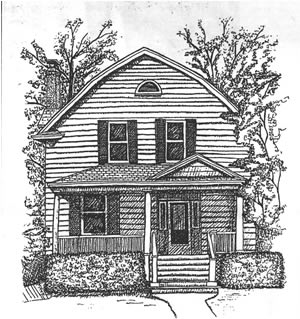 |
A.
It's a unique business, and it started as a side line for
about ten years. It was a supplement, but I had a goal in
mind. The business grew to be more over time, but it started
slow.
I
started out with a degree in interior design. I hadn't majored
in art because I didn't think that would be practical. After
school, I worked in commercial interior design for seven
years. I found that very exacting and technical. I wanted
to rekindle the artistic juices, but most of all, I wanted
to do something that allowed me to be at home with my children.
When I was divorced, my youngest was two- and-a-half years
old. Being with the children was what was really important
to me, but I wasn't sure how to do that. |
I began making greeting cards, but that did not really make very much
money. One thing lead to another and a real estate agent asked for
a house drawing. I had studied and done architectural drawing, so I
thought this was something I could do. With the greeting cards, I would
need mass production to make a profit. But the house portraits would
be low overhead.
Q. What did you do to expand the business?
A.
I put an ad in the Webster-Kirkwood Times for the holidays,
and I got a lot of calls. I was doing pen & ink and then
someone asked for watercolor, and I started doing that.
A friend and
I brainstormed about marketing and we decided to try mail
order. I had to get into wholesale pricing; the catalogue
would take a cut. I presented my work to Home Decorator
Collections Catalogue.
They put me in the catalogue. That meant cut prices but huge
volume for me to make money. Over the holidays, I was filling
ten to fifteen orders a week, so I had to hire help. After
two years, the catalogue company said that the numbers were
not working for them. |
|
I
was wondering if
this was really going to go anywhere. I decided that I had not
saturated the St. Louis market, and I realized that I
could charge what the catalogue had charged, and it would be
a raise for me. The work has evolved and improved, and
I now produce
a smaller volume at a higher profit margin.
Holidays
remain the busiest time. I now do eight to ten portraits
a month but can make more, and
I have one person working for me on a contract basis.
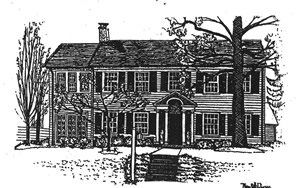 |
Q.
What in your background helped you in this endeavor to combine
your art with business?
A.
I had to be a marketer. I found out I really liked that
part of the business even though I had never taken classes
in marketing. I had to think about things like whether
my quality fit a particular market. If I do not charge
enough, I may even lose potential clients. My prices
range from $150 to $800, but for a long time I charged
just under $100. Now I have ads in
St. Louis Homes & Lifestyles Magazine and St.
Louis Seasons. I am also in the yellow pages. That advertising
paid in indirect
|
ways. St. Louis
Business Journal called me for a feature, and they had found me in the yellow
pages.
Q.
Do you have any suggestions for other people trying to make a business
out of their art?
A.
You can't give up. If you send in catalogue proposals, for instance,
and you get rejected, you have to keep trying. And working in other
businesses helped me. I learned how to deal with clients when I worked
retail while in college. When I was employed by a furniture dealer,
I learned about pricing and mark-up. I also got to know something about
setting standards for production and procedures.
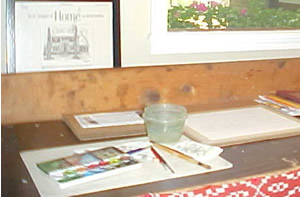 |
What I do borders
between fine art and a product. I had to develop a process.
Part is technical and part is fine art. My background in architectural
drawing and design have helped. So I developed a process, and
I can work from a photo. Employees can help with some of the
layout. Because of the time and effort involved, I have begun
charging the same for black and white drawing as for the watercolors,
and I offer four basic sizes. I was able to standardize.
I have also
had to learn to give the right jobs to the right people.
When I am training a new person, I am losing money. |
Along
the way, part of what kept me going were little signs, the personal
responses from clients, so I act like there always will be work. So
far it markets itself.
Visit
Ms. Flynn's webpage, Designs
by Mary Beth, to learn more about
her work.





